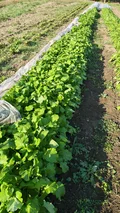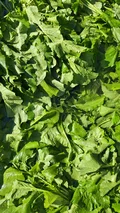TL;DR
For the most part, we harvested more tatsoi and gourds, then disced in winter rye seed. Many indoor activities were deferred until tomorrow since there’s a good chance of rain.
This past weekend, I upgraded my homelab Immich server instead of procrastinating it more with a new RAG project.
Three Cubic Yards of Gourds
If you’ve ever had a cubic yard of compost or a pallet of anything delivered, you know it bigger than it sounds like it would be. Half of them (by volume) are pumpkins while the other half are a mix of pattypan, butternut, acorn, and delicata squash.
Well, today we added another pallet-crate of gourds to storage in the garage. Counting the other crate we filled on Monday plus this one, then also all the bins in the kitchen space, we now have about three cubic yards of gourds. They will be used in CSA member shares and sold at both the farmer’s markets and the general store in Essex come November.
More Tractor Time
I got more time on the tractor, discing two fields (or about 24 rows) with the Athens attachment. I learned that a series of discs connected on a pole is called a ‘gang’ and that these gangs are often oriented in specific ways based on the operation being performed. In our case today, we are mixing the rye seed into the soil as cover crop and also tilling under various beds with spent growth in them so that we can spread rye seed there too.
I really appreciate that Jamie is educating us on tractor stuff. The only other place I would get this kind of hands-on training and practice is at an agricultural school and I don’t have the money for that while also supporting my family.
AI Summary from Field Notes
Once again, today’s summary is still based on a simple chain of consolidation based on templates. It is not supplanted yet by a RAG or otherwise more advanced agentic process since I opted to upgrade Immich because it was a chore and chores need to be done too. You can’t always be doing ‘new work’ otherwise you don’t ever know how much trouble your prior new works cause.
ASIDE: They used to call it ‘dogfooding’, but some people change it to ‘drinking your own champagne’…as if the average person owns a vineyard. Personally, I think it’s missing the point to switch one with another, somewhat snobbily doing so.
The one thing I know I need to fix is that my current prompt template says something about “…not using markdown…” but then gives an example in markdown. This sometimes causes the LLM reasoning process to loop a bit and waste both time and energy. I think I’ll also want to add in some observability over streamed ‘think’ blocks as they are coming out of the LLM using the LLMBO proxy service to catch when it generates phrases like ‘wait, ‘ or ‘I need to think about this’ to indicate that looping occurrences are happening.
The good news is that this isn’t too hard at all because I already have the OpenTelemetry bits in place and just need to create a new meter in the code, then add a new Grafana chart to visualize the data. I may also want to add a Slack notification when it happens more than once in a single think block.
Summary
Consolidated Summary
Main Themes
- Farm Operations: Crop care (gourds, basil, basil), share pickups, animal maintenance (chickens, pigs), and seasonal tasks.
- Tools & Technology: Field knives, gloves, toiletries bags, phones, GoPro cameras, and electric vans for farm tasks.
- Crop Management: Harvesting, storage, and seasonal timing (e.g., delicata timing).
- Pest & Wildlife Control: Netting, chicken fencing, and deer monitoring.
- Personal Hygiene & Safety: Injury management (band-aids, antiseptic), glove use, and sweat-related discomfort.
- Workplace Challenges: Balancing farm tasks with health, safety, and efficiency.
Activities
- Harvested gourds for share pickups and loaded an electric van.
- Watered chickens and pigs, used a field knife for harvesting, and managed a toiletries bag for injury care.
- Took photos with a phone and used a GoPro for documentation (forgotten camera highlights tech gaps).
- Wore gloves to protect an injured finger and disinfected a scraped finger multiple times daily.
New Things Identified
- Toiletries Bag Use: A specialized bag for injury management on the farm.
- Injury Management: Need for a consistent protocol for wounds and disinfection.
- GoPro Oversight: Forgotten camera highlights tech tool gaps.
- Glove Comfort: Vinyl gloves caused sweat, requiring frequent replacement.
- Crate Storage: Improved storage methods for farm produce.
- Compost Pile Management: Enhanced composting practices for farm waste.
Questions for Future Research
- How to ensure consistent use of a GoPro for farm documentation?
- What injury prevention protocols are effective for farm work?
- How to optimize the toiletries bag for injury care?
- Are there gloves that balance protection, breathability, and durability?
- How to reduce waste (e.g., vinyl gloves) while maintaining safety?
- What storage methods best preserve crop quality during seasonal timing?
Suggestions for Action
- Restock Toiletries: Ensure band-aids, antiseptic, and gloves are available.
- Implement Camera Routine: Schedule regular use of GoPro/phone for documentation.
- Create Injury Protocol: Standardize wound care steps (disinfection, glove use).
- Invest in Better Gloves: Seek durable, sweat-resistant options.
- Evaluate Storage Systems: Test crate storage and compost pile methods for efficiency.
- Track Seasonal Tasks: Monitor delicata timing and adjust harvest schedules accordingly.
Part 1
Main Themes
- Crop Management and Harvesting: Harvesting broccoli rabe, collecting gourds (delicata, patty pans, butternut squash, pumpkins), and preparing storage.
- Soil and Crop Preparation: Using a tractor to till rye seed, preparing the field for future planting.
- Pest and Animal Management: Installing netting and fencing to deter deer from damaging crops.
- Storage and Organization: Storing gourds in crates, organizing bins, and managing storage space.
- Seasonal and Crop Timing: Noting the second week of delicata distribution and the abundance of gourds.
Activities Performed by the Intern
- Washed bins for gourds and stored them in crates.
- Harvested broccoli rabe and other greens.
- Used a tractor to till rye seed (diking) for future planting.
- Collected gourds from the field, including various types (delicata, patty pans, pumpkins).
- Set up netting over a pumpkin patch to prevent deer damage.
- Installed a chicken fence around a carrot patch to protect from deer.
- Lined a crate with cardboard for gourd storage.
- Transported a crate to the garage for storage.
- Monitored deer activity and noted damage to gourds and greens.
New Things Not Yet Encountered
- Using a tractor for disking (tilling soil for planting).
- Installing netting over pumpkins to prevent deer damage.
- Using chicken fencing to protect carrot patches.
- Storing gourds in crates (a new method for organized storage).
- Lining crates with cardboard for gourd preservation.
Questions and Future Research Areas
- Effectiveness of netting: Is the netting sufficient to prevent deer damage, or will additional measures be needed?
- Deer behavior: Why is deer damage more noticeable in certain areas (e.g., pumpkins, carrots)? Is there a seasonal or crop-specific pattern?
- Storage efficiency: How does storing gourds in crates compare to bins in terms of space and accessibility?
- Timing of delicata distribution: Is the timing of delicata handing out aligned with deer activity or crop maturity?
- Fencing requirements: Should the large field fence be reduced or removed, given minimal deer damage?
Suggested Actions
- Monitor deer impact: Regularly check for damage to gourds, pumpkins, and carrots, and adjust netting/fencing as needed.
- Test netting effectiveness: Measure the extent of deer damage in the netted area versus the unnetted area.
- Evaluate storage methods: Compare crate storage (cardboard-lined) with bin storage to determine which is more practical for gourds.
- Refine fencing: Remove or reduce sections of the large field fence if deer damage is minimal, while maintaining protective measures in high-risk zones.
- Document crop yields: Track the volume of gourds stored (e.g., “two cubic yard crates”) to assess seasonal trends and storage needs.
This approach balances immediate farm tasks with long-term planning to address ecological and logistical challenges.
Part 2
Main Themes
- Farm Operations and Crop Management: Collecting and preparing crops (gourds, basil), managing share pickups, and maintaining farm supplies.
- Animal Care: Watering and tending to chickens and pigs.
- Tools and Equipment: Use of field knives, work gloves, and a toiletries bag for injury management.
- Technology and Photography: Use of a phone for photos, mention of a GoPro camera (not used due to oversight).
- Personal Hygiene and Health: Managing injuries, disinfection, and the role of gloves in preventing infection.
- Workplace Challenges: Balancing farm tasks with personal health and safety.
Activities Performed by the Intern
- Collected and prepared gourds for share pickups.
- Loaded an electric van for farm share distributions.
- Watered chickens and pigs.
- Used a field knife for tasks (e.g., cutting, harvesting).
- Took photos with a phone for documentation.
- Managed a toiletries bag, including applying band-aids and disinfectant to a scraped finger.
- Wore vinyl gloves and work gloves to protect an injured finger.
- Disinfected and cleaned the injury multiple times a day.
New Things Not Yet Encountered
- Use of a Toiletries Bag for Farm Work: The intern uses a specialized bag with band-aids, antiseptic, and other supplies for injuries.
- Injury Management on the Farm: The need for a system to handle injuries (e.g., band-aids, gloves, disinfection).
- GoPro Camera Oversight: The intern forgot the GoPro camera, highlighting a potential gap in tech tools for documentation.
- Sweat and Comfort in Vinyl Gloves: The intern notes that vinyl gloves cause sweat and require frequent replacement.
Questions and Future Areas of Research
- Tech Tools for Documentation: How can the intern ensure consistent use of a GoPro or other cameras for farm activities?
- Injury Prevention and Management: What are effective protocols for managing injuries on the farm (e.g., glove types, disinfection schedules)?
- Hygiene Practices: How can the intern optimize the toiletries bag to prevent infections and manage injuries efficiently?
- Work Glove Design: Are there gloves that balance protection, breathability, and durability for farm work?
- Sustainability of Supplies: How can the intern reduce waste (e.g., vinyl gloves) while ensuring injury protection?
Suggestions for Action
- Restock Toiletries Bag: Prioritize restocking band-aids, antiseptic, and vinyl gloves to address the injury management needs.
- Implement a GoPro/Phone Camera Routine: Establish a schedule to ensure the GoPro is used for documentation, avoiding oversight.
- Develop an Injury Protocol: Create a checklist for wound care, including disinfection, glove use, and monitoring for infections.
- Invest in Better Work Gloves: Explore gloves that reduce sweat and allow for longer wear while protecting against injuries.
- Track Supply Usage: Monitor the frequency of vinyl glove replacements and adjust supplies based on needs.
This analysis highlights the intern’s daily responsibilities, challenges, and opportunities for improvement in farm operations and personal health management.
[end of post]
Enjoy Reading This Article?
Here are some more articles you might like to read next:







